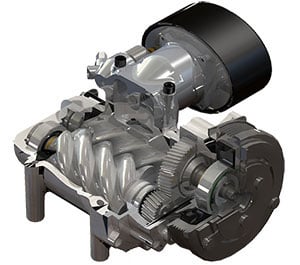The Top 10 FAQs About Compressed Air – Fun Facts About Compressed Air
You’ve got questions, and we’ve got answers! In this article, we’ll tell you everything you ever wanted to know about compressed air and then some.
Here are the top 10 compressed air questions we’ve answered for you:
- What is compressed air made of?
- How is air compressed?
- What causes pressure in compressed air?
- Why is compressed air hot?
- What is compressed air used for?
- What are the benefits of compressed air?
- Why do we need compressed air?
- Is compressed air safe?
- Can compressed air explode?
- Can compressed air kill you?
Let’s get started!
What is compressed air made of?
Compressed air is made of the same air you breathe in and out, but that air is compressed into a smaller size and kept under pressure. When you take atmospheric air and physically force it into a smaller volume, the molecules take up less space; voila, the air is compressed.
Atmospheric air and compressed air are both made up of:
The “ingredients” in the air don’t change when it’s compressed—just the amount of space those molecules take up.
How is air compressed?
Air is compressed in two simple steps:
Step 1: Air is trapped in a cylinder, tank, or similar container
Step 2: The space in that container becomes smaller, which forces the air molecules closer together
The now-compressed air remains trapped in this smaller state, waiting to expand again until it’s ready for use.
Compressing air is easiest to picture with a reciprocating air compressor, where a piston pushes the air down in a cylinder. Here’s a great reference image:

(Source: Encyclopedia Britannica)
But pistons aren’t the only way to force air into a smaller space. There are numerous styles of air compressors on the market, each with its advantages and disadvantages. For example, rotary screw air compressors use dual spinning screws to push air down and compress it:

Rotary screw air compressors are chosen over reciprocating because they are compact, powerful, and can run continuously. If you're interested, you can read more about the differences between rotary screw and reciprocating air compressors here.
Regardless of the mechanism used, air is always compressed by taking atmospheric air and squishing it down so the molecules are condensed and pressurized.
What causes pressure in compressed air?
You know when you’re crammed in a busy elevator, the door suddenly opens, and everybody rushes out and spreads apart? Compressed air does the same thing. While the molecules in air can be trapped in a smaller space, they don’t want to be, and they will spread apart as quickly as possible the first second they can. That’s what causes pressure.
Atmospheric air has 14 PSI of pressure (1 bar) but can be forced up to 6004 PSI (414 bar) of pressure when compressed into a smaller state. Exactly how pressurized compressed air becomes is determined by science.
Three scientific laws explain air pressure:
- Boyle’s Law explains that if air volume halves during compression, the pressure is doubled.
- Charles’ Law states that the volume of air changes in direct proportion to the temperature.
- The First Law of Thermodynamics tells us that an increase in pressure equals a rise in heat and that compressing air creates a proportional increase in heat.
Collectively, these three laws explain that pressure, volume, and temperature are proportional. If you change one variable, then one or two of the others will also change, according to this equation:

When applying this formula to an air compressor, the air volume and pressure can be controlled and increased as needed. You can use compressed air in pressure ranges from 14 PSI to 6004 PSI (1 to 414 bar) at flow rates from as little as 3.5 CFM (0.1 m³) and up.
Fortunately, most people have no reason to memorize or use this formula. Instead, just set your air compressor to your desired pressure and let science take care of the rest.
Why is compressed air hot?
Compressed air is hot because the air molecules are physically forced closer together during compression, which causes the molecules to move quickly; this rapid molecule movement generates heat.
Depending on the application, the compressed air that leaves an air compressor system can be hundreds of degrees. However, the compressed air that leaves an air compressor is typically not as hot as the air inside the compression chamber.
Hot air can be dangerous, and heat also increases the water in the air stream, which can be a problem in some applications. When necessary, air compressor designs can include aftercoolers to reduce the compressed air temperature, and in turn reduce the amount of water in the air stream.
What is compressed air used for?
Compressed air is useful in two ways:
- As an energy source
- As blowing air (“active air”)
Compressed air can power air tools and production equipment when used as an energy source. Tools and equipment powered by compressed air are in countless applications across dozens of industries, including construction, tire service, mechanical repair, maintenance, factory production, industrial processes, and vehicle safety systems. Even roller coasters use compressed air!

Active air is used when a steady stream of air is needed for a task. A couple of literal applications for active air are aeration and medical breathing air. But tons of other industries, from pharmaceutical and chemical companies to food and beverage plants, use active air in their processes to produce goods and services.
What are the benefits of compressing air?
Compressed air is a popular energy source for many reasons. The main benefits of using air compressors and compressed air are:
- Improved productivity
- Cheap power source
- Safe when used properly
- Energy efficient
- Low operating costs
- Versatile tools & applications
- Compact, light & easy to move
- Low theft rates
If you need more convincing than that, you can find out why VMAC’s existing customers love compressed air here.
Why do we need compressed air?
Compressed air is the fourth utility. Although not as ubiquitous as electricity, petroleum products, or gas, compressed air is fundamental in powering our modern world. It plays a vital role in most modern manufacturing processes in today’s civilization.
Although you may not realize it, most products we use today were made using compressed air at some point. In fact, compressed air accounts for about 10% of the global energy currently used.
The main difference between compressed air and other power sources is that users can easily generate their own air and choose how to generate it. As a result, air compressors can accommodate a lot of different needs. Many applications in different environments depend on compressed air, and air compressors can be configured (with the right accessories) to compress air to a specific pressure, at a certain flow, and of the right quality.
Is compressed air safe?
Yes. Compressed air is clean, safe, simple, and efficient, as far as energy sources go. There are no dangerous exhaust fumes or other harmful by-products when compressed air is used, and it is a non-combustible, non-polluting utility.
However, compressed air can be dangerous when misused or if air receiver tanks aren’t properly maintained. Therefore, operators should always follow the guidelines set by manufacturers.
Can compressed air explode?
It is possible for an air receiver tank holding compressed air to explode—but it’s extremely rare and tends to occur when operators don’t look after their air receiver tank.
The leading cause of air compressor tank explosions is corrosion. When operators don’t drain the water that accumulates in their tank, it can cause corrosion, weakening the tank until the compressed air breaks it open.
The second common cause of an air tank explosion is poorly manufactured products or manufacturing defects. For example, an air receiver tank without a proper pressure relief valve might become over-pressurized and explode from that. Working with a reputable air receiver tank manufacturer should prevent these types of explosions from occurring.
Explosions & Canned Air
Keep in mind that canned air, those small cans of compressed “air” used to clean electronics and computer equipment, is not the same thing as true compressed air. Canned air is a highly flammable chemical gas called difluoroethane, which has a higher chance of causing an explosion.
The Backyard Scientist has a pretty cool YouTube video that shows the impressive explosive reaction between hot water and difluoroethane:
But again, that’s not the kind of compressed air that comes from an air compressor.
Horror stories and YouTube distractions aside, it’s very unlikely that compressed air will cause an air receiver tank to explode. Properly drained and maintained tanks pose very little risk to their operators.
Can compressed air kill you?
Compressed air is safe when used correctly. However, messing around with compressed air or using it in unconventional ways can be dangerous and even deadly.
Here are a few ways that compressed air can kill or seriously injure a person:
- Compressed air blown into the skin can obstruct an artery and result in an embolism
- Inhaled compressed air can rupture your lungs or esophagus
- Compressed air blown into the ear can rupture eardrums and cause brain damage
- Compressed air can blow eyes out of their sockets
Although all these occurrences are extremely rare, they are also possible. There is no good reason to point compressed air at a person, including yourself, which makes these injuries 100% preventable. Don’t use compressed air to clean your clothes, blow dust around, or hit your buddy as a joke, and you’ll be perfectly safe.
However, the chemicals found in canned air are a threat and it’s rarely a great idea to inhale chemicals.
So, yes, compressed air and canned air can kill you, but only if you’re using them improperly.
Want to keep learning? Check out our Guide to Rotary Screw Air Compressors!
